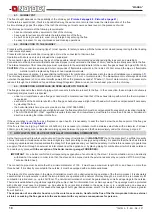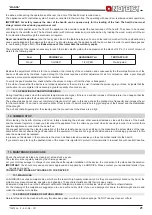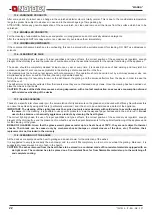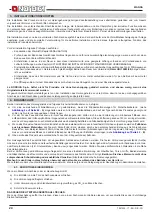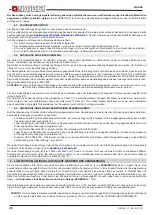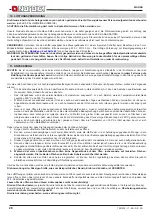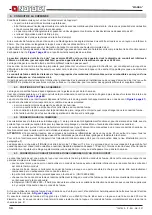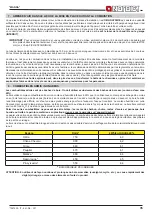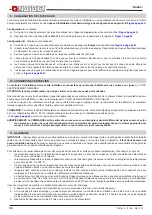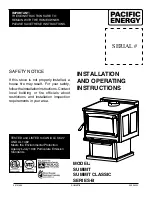
21
the ashes, while during the operation and the rest, the door of the hearth must remain closed.
The appliances with constructive system 2 must be connected to their own flue. The operating with open door is allowed under supervision.
IMPORTANT: For safety reasons the door of the hearth can be opened only for the loading of the fuel. The hearth door must
always remain closed during operation or rest
.
With the controls positioned on the front of the appliance it is possible to adjust the heat emission of the hearth. They have to be opened
according to the calorific need. The best combustion (with minimum emissions) is reached when, by loading the wood, most part of the air
for combustion flows through the secondary air register.
Never overload the appliance
(see the hourly wood load in the table here below). Too much fuel and too much air for the combustion may
cause overheating and then damage the stove. You should always use the appliance with the door closed in order to avoid damages due
to overheating (forge effect).
The inobservance of this rule makes the warranty expire
.
The adjustment of the registers necessary to reach the rated calorific yield with a depression at the stack of 14 Pa (1,4 mm of column of
water) is the following one:
Fuel
PRIMARY air
SECONDARY air
TERTIARY AIR
Wood
CLOSED
1/2 OPEN
Pre-adjusted
Besides the adjustment of the air for the combustion, the intensity of the combustion and consequently the thermal performance of the
device is influenced by the stack. A good draught of the stack requires a stricter adjustment of air for combustion, while a poor draught
requires a more precise adjustment of air for combustion.
To verify the good combustion, check whether the smoke coming out from the stack is transparent.
If it is white, it means that the device is not properly adjusted or the wood is too wet; if instead the smoke is gray or black, it signals that the
combustion is not complete (it is necessary a greater quantity of secondary air).
11.2. OPERATION IN TRANSITION PERIODS
During transition periods when the external temperatures are higher, if there is a sudden increase of temperature it can happen that the
combustion gases inside the flue cannot be completely sucked up.
The exhaust gases do not come out completely (intense smell of gas). In this case, shake the grating more frequently and increase the air
for the combustion. Then, load a reduced quantity of fuel in order to permit a rapid burning (growing up of the flames) and the stabilization
of the draught.
Then, check that all openings for the cleaning and the connections to the stack are air-tigh.
12. SUMMER STOP
After cleaning the hearth, chimney and hood, totally eliminating the ash and other eventual residues, close all the doors of the hearth
and the relevant registers; in case you disconnect the appliance from the chimney you must close its openings in order to let work others
possible appliances connected to the same flue.
We suggest performing the cleaning operation of the flue at least once per year; verifying in the meantime the actual status of the rope
seals, which cannot ensure the good operation of the equipment if they are not in good condition and are not making a good seal! In this
case the seals must be replaced.
In presence of dampness in the room where the stove has been placed, we advise you to put absorbent salts into the hearth.
If you want to keep for long the aesthetic look of the cooker it is important to protect its internal walls in row cast iron with neutral Vaseline.
13. MAINTENANCE AND CARE
Check the external air intake, by cleaning it, at least once a year.
The stack must be regularly swept by the chimney sweeper.
Let your chimney sweeper in charge of your area check the regular installation of the device, the connection to the stack and the aeration.
IMPORTANT:
You should only use spare parts approved and supplied by La NORDICA. Please contact your specialized retailer if you
require spare parts.
YOU MUST NOT MAKE ANY CHANGES TO THE DEVICE!!!
13.1. MAJOLICAS
LA NORDICA has chosen majolica tiles, which are the result of high-quality artisan work. As they are completely carried out by hand, the
majolica may present crackles, speckles, and shadings. These characteristics certify their precious origin.
Enamel and majolica, due to their different coefficient of dilatation, produce microcrackles, which show their authentic feature.
For the cleaning of the majolica we suggest you to use a soft and dry cloth; if you use a detergent or liquid, the latter might soak in and
make the crackles more visible.
13.2. PRODUCTS MADE OF NATURAL STONE
Natural stone has to be cleaned with very thin abrasive paper or with an abrasive sponge. Do NOT use any cleanser or fluid.












